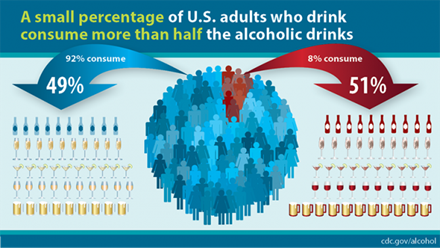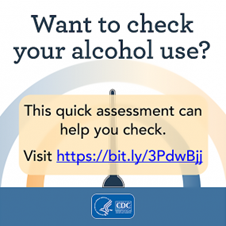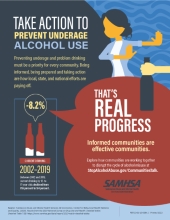Home > PTTC Post Article - April 2023
Author: Cele Fichter-DeSando, MPM
Each month the PTTC Post communicates tips and information on best practices along with features, information about national professional development events and funding opportunities, links to state-of-the-art online resources, and other electronic publications relevant to the field.
April is Alcohol Awareness Month and this month’s PTTC Post focuses on promoting awareness and providing education on preventing underage alcohol use and preventing alcohol misuse for all populations. The Substance Abuse and Mental Health Services Administration’s (SAMHSA) 2021 Report to Congress on the Prevention and Reduction of Underage Drinking indicates that prevention strategies are most effective when implemented as part of a multifaceted approach that includes parents and families, law enforcement, health care providers, community organizations, schools and universities, local and state governments, and the federal government (SAMHSA, 2022). Implementing multifaceted prevention programs requires staying connected to and building relationships with the populations who are the focus of the program. For alcohol awareness month this includes paying attention to specific risk and protective factors associated with alcohol use and alcohol use disorders.
The Risk of Disengagement
For many years research studies have shown that socially anxious youth who avoid negative situations and disengage as a means of coping are at risk for increased alcohol use ( Blumenthal et al., 2015). This is particularly concerning given new reports about the struggles facing adolescents and young people. Recently, the Centers for Disease Control (CDC) released its first national Youth Risk Behavior Survey (YRBS) data collected since the beginning of the COVID-19 pandemic. Youth Risk Behavior Survey Data Summary & Trends Report: 2011-2021 summarizes surveillance data and 10-year trends related to adolescent health and well-being. The YRBS report shows that nearly 3 in 5 (57%) U.S. teen girls felt persistently sad or hopeless in 2021 representing a nearly 60% increase and the highest level reported over a decade. All teens reported increasing mental health challenges, experiences of violence, and suicidal thoughts and behaviors, but the percentage of girls experiencing sadness and/or hopelessness was double that of boys with girls faring worse than boys across nearly all measures. Increasing levels of ongoing sadness or hopelessness were found across all races and ethnicities with reported suicide attempts having increased among Black and White youth. The CDC report also confirms ongoing and extreme distress among teens who identify as lesbian, gay, bisexual, or questioning (LGBQ+); more than half (52%) of LGBQ+ students had recently experienced poor mental health and, more than 1 in 5 (22%) attempted suicide in the past year (CDC, 2023). - It is important to note that comparison from past year trend data is not available for students who identify as LGBQ+ due to changes in survey methods.
In addition to the CDC report, the 2021 National Survey on Drug Use and Health (NSDUH) surveyed participants on their perceptions of how the COVID-19 pandemic affected their well-being. In the Highlights for the 2021 National Survey on Drug Use and Health, it is reported that nearly half of the adolescents aged 12 to 17 with a past year major depressive episode (45.1% or 2.2 million people) thought that the COVID-19 pandemic negatively affected their mental health “quite a bit or a lot,” while 12.4% of adolescents aged 12 to 17 (2.4 million) without a past year major depressive episode reported that COVID-19 impacted their mental health “quite a bit or a lot.” Most adults aged 18 or older in 2021 perceived a negative effect of the COVID-19 pandemic on their mental health. 49.7% of adults (124.4 million people) perceived “a little or some” negative effect on their mental health and about 1 in 7 adults aged 18 or older (14.4 percent or 36.1 million people) perceived that the COVID-19 pandemic negatively affected their mental health “quite a bit or a lot.” Similar to adolescents (12-17), nearly half of adults aged 18 and older (48.9% or 6.8 million people) perceived a negative impact associated with COVID-19 on their mental health (SAMHSA, 2022).
A systematic review of the emotional processes in binge drinking found that binge drinking is related to heightened negative emotional states, including greater severity of depressive and anxiety symptoms, and those who engage in binge drinking exhibit diminished emotional response compared with non-binge drinkers (Lannoy et al.,2021).

According to the CDC, excessive alcohol use is a leading preventable cause of death in the United States, shortening the lives of those who die by an average of 26 years. Excessive alcohol use includes:
Highlights for the 2021 National Survey on Drug Use and Health show that
The 2021 National Survey on Drug Use and Health (NSDUH) used multimode data collection, in which respondents completed the survey in person or via the web. The 2021 estimates are not comparable with estimates from the 2020 NSDUH or prior years and should stand alone as indicators of current alcohol use (SAMHSA, 2023).
 The Risk of Avoidant Coping Strategies
The Risk of Avoidant Coping Strategies
Understanding the current landscape associated with mental health, well-being, and alcohol use will provide direction for effective prevention and intervention. An online survey of more than 1000 college students published in the American Journal of College Health found that alcohol is often used by students as an avoidant and maladaptive coping strategy, to avoid confronting the stressors associated with college. The study concludes that approach-oriented strategies, that focus on directly addressing stressors and stress reduction could be beneficial to integrate into prevention efforts by many different service providers (Metzger et al., 2017).
A Vanderbilt University 2017 study found that when participants reported using adaptive (problem-solving) strategies, for example, looking at a problem in a different way, engaging in problem-solving, or pursuing constructive communication, they were better able to manage the adverse effects of stress. Those who used maladaptive strategies like suppressing, avoiding, or denying their feelings, had higher levels of problems associated with stress (Compas, 2017).
Including approach-oriented, problem-solving strategies during Alcohol Awareness Month will increase connection, communication, and engagement. Alcohol Awareness month provides an opportunity to reach out to those who are sad, hopeless, disengaged, anxious, and stressed with focused communication, health and well-being promotion, and solutions and resources for help.
Below are some resources to assist communities and prevention professionals in the planning and delivery of focused alcohol misuse prevention.
National Institute on Alcohol Abuse and Alcoholism (NIAAA) provides Science-Based Resources about Alcohol and Health that includes brochures, fact sheets, webpages, and the NIAAA Spectrum webzine featuring topics such as alcohol and the brain, alcohol flush reaction, binge drinking, women and alcohol, prenatal alcohol exposure, underage drinking, college drinking prevention, and many more. NIAAA offers a webpage devoted to statistics about alcohol as well as surveillance reports, epidemiologic resources, and a peer-reviewed scientific journal (NIAAA, 2023).
Especially for Alcohol Awareness Month, the Northwest PTTC has launched the 2023 Alcohol Awareness Toolkit #ProofIsInTheNumbers. The Alcohol Awareness Toolkit seeks to help prevention and public health professionals, and community organizations:
2023 Weekly Themes
Week 1: Harms to Others/Impaired Driving/Violence (April 2-8)
Week 2: Alcohol and The Economy (April 9-15)
Week 3: Alcohol’s Role in The Opioid Epidemic (April 16-22)
Week 4: Alcohol and Cancer & Excessive Alcohol Use (April 23-29)
SAMHSA has resources to help parents, caregivers, and other caring adults who talk with young people about the risks and harms of using alcohol and other substances of misuse. Promoting Alcohol Misuse Prevention this April | SAMHSA includes the latest research, fact sheets, community stories, activities, and digital downloads to use in your programming (SAMHSA, 2022).

Cele Fichter-DeSando, MPM
CFD Consulting, LLC
[email protected]
412-580-3089
References
Blumenthal, H., Ham, L. S., Cloutier, R. M., Bacon, A. K., & Douglas, M. E. (2016). Social anxiety, disengagement coping, and alcohol-use behaviors among adolescents. Anxiety, stress, and coping, 29(4), 432–446. https://doi.org/10.1080/10615806.2015.1058366
Centers for Disease Control and Prevention (CDC) (2022). Excessive alcohol use factsheets. CDC, July 2022. https://www.cdc.gov/chronicdisease/resources/publications/factsheets/alcohol.htm
Centers for Disease Control and Prevention (CDC), (2023). U.S. teen girls experiencing increased sadness and violence. CDC, February 2023. https://www.cdc.gov/media/releases/2023/p0213-yrbs.html
Compas, B. E., Jaser, S. S., Bettis, A. H., Watson, K. H., Gruhn, M. A., Dunbar, J. P., Williams, E., & Thigpen, J. C. (2017). Coping, emotion regulation, and psychopathology in childhood and adolescence: A meta-analysis and narrative review. Psychological bulletin, 143(9), 939–991. https://doi.org/10.1037/bul0000110
Lannoy, S., Duka, T., Carbia, C., Billieux, J., Fontesse, S., Dormal, V., Gierski, F., López-Caneda, E., Sullivan, E. V., & Maurage, P. (2021). Emotional processes in binge drinking: A systematic review and perspective. Clinical psychology review, 84, 101971. Advance online publication. https://doi.org/10.1016/j.cpr.2021.101971
Metzger, I. W., Blevins, C., Calhoun, C. D., Ritchwood, T. D., Gilmore, A. K., Stewart, R., & Bountress, K. E. (2017). An examination of the impact of maladaptive coping on the association between stressor type and alcohol use in college. Journal of American college health : J of ACH, 65(8), 534–541. https://doi.org/10.1080/07448481.2017.1351445
National Institute on Alcohol Abuse and Alcoholism (NIAAA). (2023) Science-based resources about alcohol and health. NIAAA Directors Blog, February 2023. https://www.niaaa.nih.gov/about-niaaa/directors-page/niaaa-directors-blog/looking-science-based-resources-about-alcohol-and-health
Prevention Technology Transfer Network (PTTC). (2023). Alcohol Awareness Toolkit. PIIC, 2023. https://pttcnetwork.org/centers/northwest-pttc/alcohol-awareness-toolkit
Substance Abuse and Mental Health Services Administration. (2022). Key substance use and mental health indicators in the United States: Results from the 2021 National Survey on Drug Use and Health (HHS Publication No. PEP22-07-01-005, NSDUH Series H-57). Center for Behavioral Health Statistics and Quality, Substance Abuse and Mental Health Services Administration. https://www.samhsa.gov/data/report/2021-nsduh-annual-national-report
Substance Abuse and Mental Health Services Administration. (2022).Promoting Alcohol Misuse Prevention This April. SAMHSA. April, 2022. https://www.samhsa.gov/blog/promoting-alcohol-misuse-prevention-april